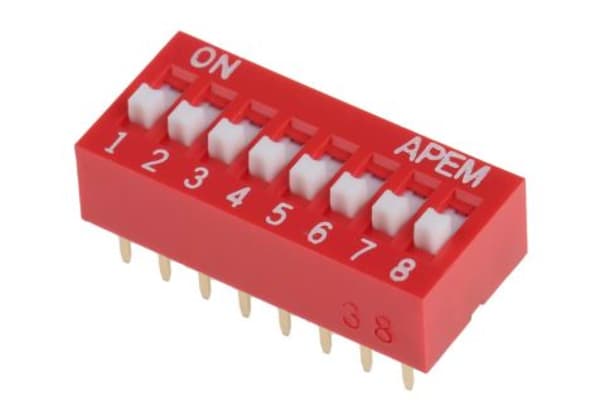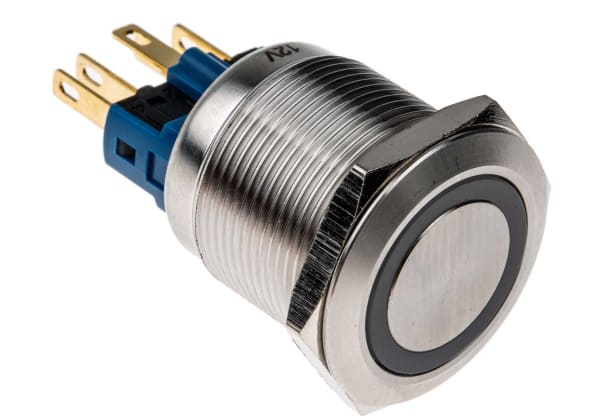- Published 17 Jan 2023
- Last Modified 27 Nov 2023
- 7 min
A Complete Guide to Toggle Switches
Our toggle switches guide explains how they work, the different types, and contact configurations available.

Reviewed by Jay Proctor, Technical Support Team Leader (September 2021)
What are Toggle Switches?
Toggle switches are a type of electronic switch, one of the most basic and widely used electrical components. Electronic switches provide on-off control for electrical circuits by interrupting the flow of current or allowing it to resume. This is achieved by removing a metal contact from the terminal (endpoint of a circuit) or bringing the two back into contact.
When the contact is connected, the circuit is closed - live - electrical current can flow through and the attached device will turn on and operate. Then when the contact is moved away again the flow of current is broken, the circuit becomes open and the device is switched off.
Toggle switches feature a manually operated hinge, handle or lever mechanism - called a toggle - which moves from one position to another. In each position, it will normally latch into place and remain there until moved back.
Toggle switches are actuators - devices that switch a machine on or off. They are similar in function to rocker switches, but the latter feature a see-saw shaped button that swings from one position to another and are sometimes classed as a type of rocker switch.
Toggle switches are also known as joystick switches and toggle power switches. They are versatile devices and can be used with almost any electrical application.
Toggle Switch Applications
The toggle switch has a multitude of functions, from the simple (switching a kettle device on or off) to the complex (controlling multiple high voltage circuits).
By far the most familiar form is the light switch - so unobtrusive and yet so central to everyday life.
You will also find toggle switches in:
- Domestic, commercial and industrial power points
- Air conditioning systems
- Many types of industrial and electrical equipment, from conveyor belts to RCDs (residual current devices)
- Aeroplane control panels
- Vehicles
Toggle switches for cars allow drivers to quickly access headlights, indicator lights, and similar controls.
How Does a Toggle Switch Work?
Although available in different designs and configurations, the fundamental toggle switch design is as follows. An armature (component carrying electrical current) attached to the toggle moves when this is pulled, placing an electrical contact into a circuit or removing it, thereby activating or deactivating the circuit.
The switch will normally remain in position until manually moved once more, although momentary switches also include an attached spring which will pull the actuator back to its starting point once released.
Toggle Switch Types
As a basic electronic component, toggle switches are available in multiple sizes and designs for use in different settings.
The internal contact points are made from a variety of conductive metals, including brass, copper and silver, often plated with gold or nickel. Toggle switches also offer different levels of contact resistance (i.e. sensitivity to electrical current) and different maximum current ratings.
Let’s take a look at some of the key toggle switch models:
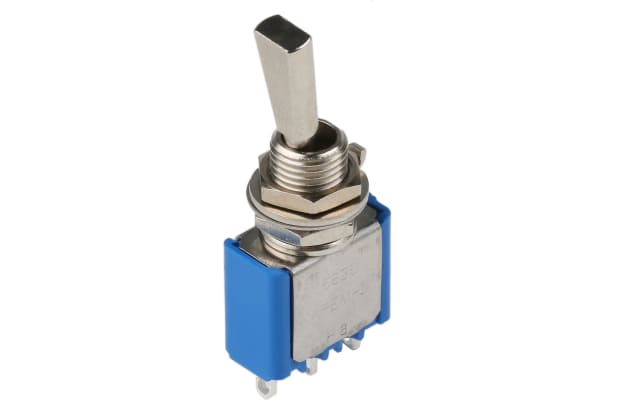
On-On Toggle Switches
On-on switches control two devices; each position of the switch activates one of the two. They are also known as changeover switches.
A variant model - the On-(On) switch - combines a standard click position with a spring-loaded one which will snap back if not held in position.

On-Off Toggle Switches
This is the most basic toggle switch design, providing simple, binary on-off control for power supplies. On-off toggle switches usually make an audible clicking noise when moved from one position to the next. They are also known as positive on-off switches.
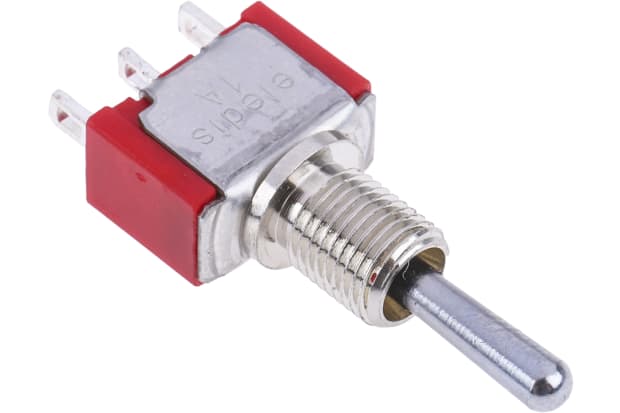
On-Off-On Toggle Switches
On-off-on toggle switches are variations of the on-on design. They add a third, neutral off position in the centre. In (on) off (on) switches, the off position is the default resting position and both on positions will click back to this once released.
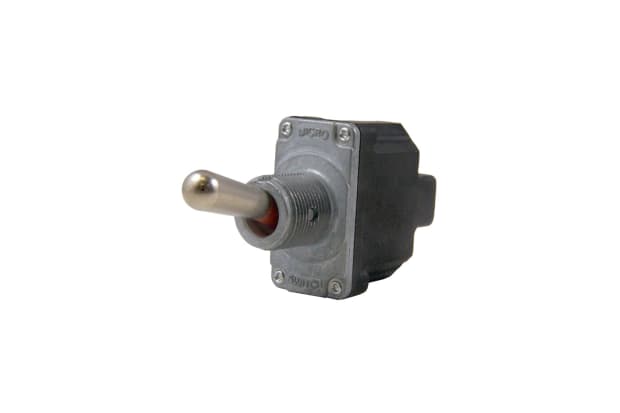
Momentary Toggle Switches
The term momentary refers to switches fitted with a spring, which clicks the toggle back into its off state once released. Most toggle switches have a momentary variant, and this is indicated with brackets - e.g. (on)-off-(on).
Momentary toggle switches commonly have a 12V or 15A rating.
Other Toggle Switch Types
Toggle Switch with Cover
These switches feature covers or caps which serve various functions. They can protect the tips of the internal lever mechanism, prevent the switch from being activated accidentally or click the switch off when closed.
Flat Toggle Switch
The term flat toggle switch may refer to switches with a flat-sided toggle, or switches in flat metal plates for vertical or horizontal fitting (for example on walls or the sides of machinery).
LED Toggle Switch
LED toggle switches include a light-emitting diode (LED), typically in the tip of the toggle, which indicates the status of the switch (i.e. on or off).
A variety of matching accessories are available.
Mini Toggle Switches
These smaller toggle switches are also known as microswitches or snap action switches. They feature a sensitive spring-loaded toggle and respond to a small amount of applied force. The spring is energised by the inflow of current and this moves the contacts into place.
Principally designed for lower currents, microswitches are cheap and widely used in both domestic and industrial equipment, often as sensors to detect the position of a component for safety reasons. For example, they can be used to ensure a door or hatch is shut before power is activated and to trigger a shutdown of the current when the door or latch is reopened.
Mini toggle switches are used in:
- Microwave ovens
- Elevators
- Vending machines
- Industrial anemometers and control circuits
Microswitches are typically fitted in complex configurations. They are resistant to damage from electric surges or arcs.
Large Toggle Switches
Large toggle switches are designed to provide on-off control. They are used in settings where visibility and easy access are crucial - for example, aeroplane control panels. Some feature two linked toggles.
Contact Configuration
Beneath the surface complexity, there are four basic toggle switch designs, each featuring a different combination of poles and throws. Poles are the individual power supplies controlled by each switch, while throws are the different positions available to the switch - e.g. on and off.
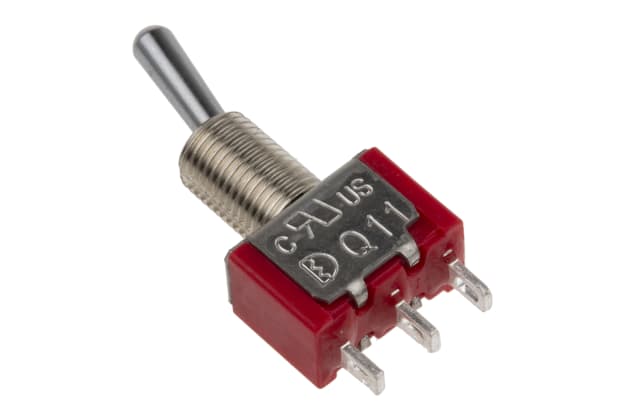
Single Pole Double Throw (SPDT)
A single pole double throw switch changes the direction of voltage, allowing a single current to be switched between two devices, activating or deactivating them. They are used in car engines and many other settings.
These are also known as two-way switches or on on toggle switches. Another variation is the three-position or three-way switch, which can be used to control a single device - for example, a light switch - from two different locations.

Single Pole Single Throw (SPST)
These are basic on-off switches - a single incoming current is directed towards a single device in an open or closed circuit. This is the common design seen in light switches.
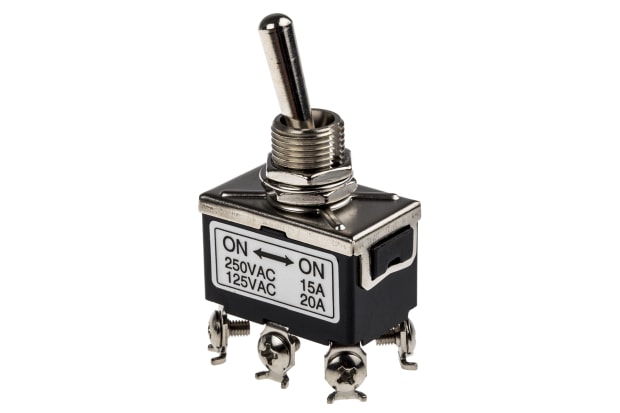
Double Pole Double Throw (DPDT)
Double pole double throw switches are in effect two on-off switches operating in conjunction with one another. They allow the voltage supplied to a particular device to be varied. Uses include reversing switches in electric motors.
Both on-on or on-off-on switches are DPDT. They are also known as four-position or four-way switches.

Double Pole, Single Throw (DPST)
Double pole single throw switches allow two different circuits to be switched on or off simultaneously, enabling easy control of two devices operating alongside each other.
